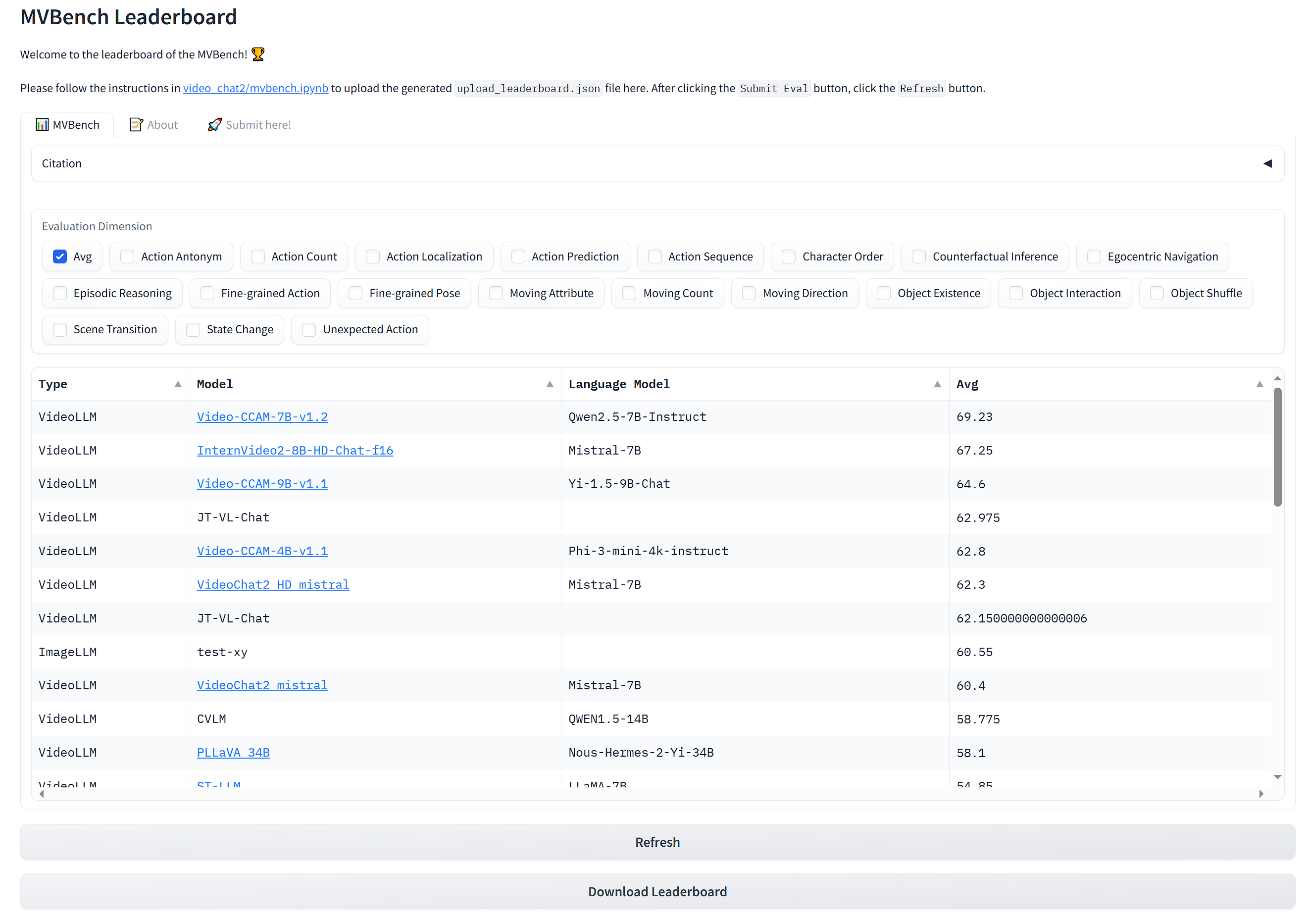Video-CCAM: Enhancing Video-Language Understanding with Causal Cross-Attention Masks for Short and Long Videos
-
2024/09/29 Video-CCAM-v1.2 has been released, featuring: 1. Enhanced performance on public benchmarks. 2. Support for Chinese. 3. Deployment with Gradio. Have a try!
-
2024/08/28 The technical report is released.
-
2024/08/22 Video-CCAM-v1.1 comes out, with better performances than Video-CCAM in many benchmarks, especially in MVBench, VideoVista, and MLVU. The technical report is coming soon. The source code is rewritten for simpler deployment. If you are interested in previous scripts, please refer to the
v1.0release. -
2024/08/21 Support VideoVista evaluation.
-
2024/07/22 Support MLVU evaluation. With 96 frames, Video-CCAM-14B achieves M-Avg as 60.18 and G-Avg as 4.11. Besides, Video-CCAM models are evaluated on VideoVista, ranking 2nd and 3rd among all open-source MLLMs.
-
2024/07/16: Video-CCAM-14B is released, which achieves 53.2 (without subtitles) and 57.4 (with subtitles) [96 frames] on the challenging Video-MME benchmark. With 16 frames, it achieves 61.43.
-
2024/06/29: Support MVBench evaluation. With 16 frames, Video-CCAM-4B achieves 57.78, while Video-CCAM-9B achieves 60.70.
-
2024/06/28: Video-CCAM-9B is released, which achieves 50.6 (without subtitles) and 54.9 (with subtitles) [96 frames] on the challenging Video-MME benchmark. After increasing the number of frames to 96, Video-CCAM-4B also has better scores as 49.6 (without subtitles) and 53.0 (with subtitles).
-
2024/06/24: Video-CCAM-4B is released, which achieves 48.2 (without subtitles) and 51.7 (with subtitles) [32 frames] on the challenging Video-MME benchmark.
Video-CCAM is a series of flexible Video-MLLMs developed by TencentQQ Multimedia Research Team.
Inference using Huggingface transformers on NVIDIA GPUs. Requirements tested on python 3.9/3.10.
pip install -U pip torch transformers accelerate peft decord pysubs2 imageio
# flash attention support
pip install flash-attn --no-build-isolation
import os
import torch
from huggingface_hub import snapshot_download
from PIL import Image
from transformers import AutoImageProcessor, AutoModel, AutoTokenizer
from eval import load_decord
os.environ['TOKENIZERS_PARALLELISM'] = 'false'
# if you have downloaded this model, just replace the following line with your local path
model_path = snapshot_download(repo_id='JaronTHU/Video-CCAM-7B-v1.2')
videoccam = AutoModel.from_pretrained(
model_path,
trust_remote_code=True,
torch_dtype=torch.bfloat16,
device_map='cuda:0',
attn_implementation='flash_attention_2'
)
tokenizer = AutoTokenizer.from_pretrained(model_path)
image_processor = AutoImageProcessor.from_pretrained(model_path)
messages = [
[
{
'role': 'user',
'content': '<image>\nDescribe this image in detail.'
}
], [
{
'role': 'user',
'content': '<video>\n请仔细描述这个视频。'
}
]
]
images = [
[Image.open('assets/example_image.jpg').convert('RGB')],
load_decord('assets/example_video.mp4', sample_type='uniform', num_frames=32)
]
response = videoccam.chat(messages, images, tokenizer, image_processor, max_new_tokens=512, do_sample=False)
print(response)
Please refer to tutorial.ipynb for more details.
To launch a Gradio demo locally, please first install gradio:
pip install gradio
Then run the following command:
python web_demo.py --model_path <your_local_path>
The demo is shown in the following figure. You can change the generation configuration (max_new_tokens, temperature, top_k, ...) and the video sampling configuration in the left panels.
- xtuner: Video-CCAM is trained using the xtuner framework. Thanks for their excellent works!
- Phi-3-mini-4k-instruct, Phi-3.5-mini-instruct, and Phi-3-medium-4k-instruct: Powerful language models developed by Microsoft.
- Qwen2.5-7B-Instruct: Excellent language models developed by Alibaba Cloud.
- Yi-1.5-9B-Chat: Powerful language models developed by 01.AI.
- SigLIP SO400M: Outstanding vision encoder developed by Google.





